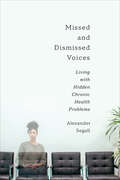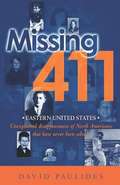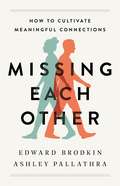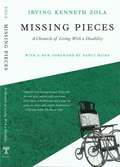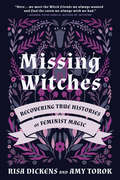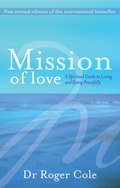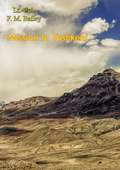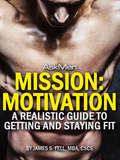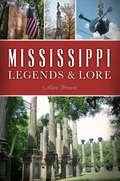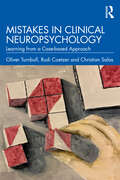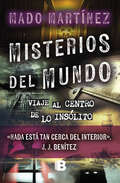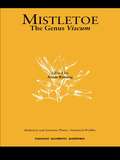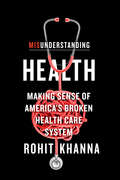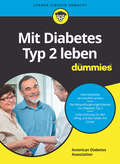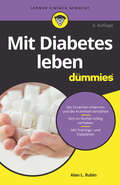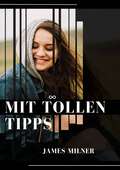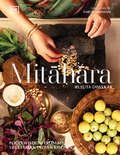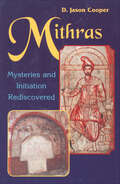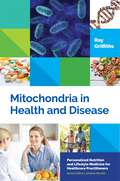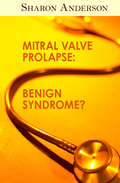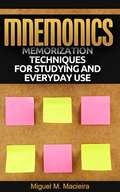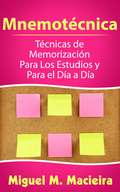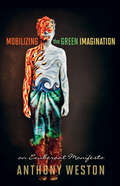- Table View
- List View
Missed and Dismissed Voices: Living with Hidden Chronic Health Problems
by Alexander Segall PhDThere is a complex relationship between illness and identity. Missed and Dismissed Voices aims to expose the impact of hidden health problems on the daily lives of a growing number of adults who live with chronic conditions and repeatedly face the challenge of trying to maintain their personal sense of healthiness across the life course. The book focuses on the meaning and management of both medically diagnosed chronic diseases and medically unexplained physical conditions or syndromes. In each case, people must decide whether to make their private suffering public. The book includes analysis derived from research literature, combined with illness narrative accounts of people in qualitative interviews and blog posts, to create fictional exemplary case studies for each of the chronic conditions examined. The common issues raised in these stories provide important insights into the process by which people manage to adapt to their changing health status and life circumstances. In this book, Alexander Segall, PhD, gives voice to chronically ill people who often have their life stories either missed or dismissed.
Missing 411- Eastern United States: Unexplained Disappearances of North Americans That Have Never Been Solved
by David PaulidesPeople have been disappearing under mysterious circumstances for centuries. During the last 150 years the media has covered many of these cases and has attempted to put a rational spin on a very unusual event. After 3+ years and 7000 hours of intensive research there is a new paradigm being presented on people missing in the wilds of North America. "Missing 411" identifies 28 clusters of missing people who have vanished in remote areas of the continent. The finding is a troubling fact questioning why and how these people have disappeared. Some of the victims are found and tell a very interesting and mind bending story of their experience, others are never found, a fact that confounds searchers and law enforcement. There are many children that have disappeared under highly unusual circumstances. After weeks of searching and failing to find any evidence of the child being in a remote location, many parents and law enforcement draw the conclusion that the victim was kidnapped, yes, taken by someone lurking in remote areas of our national parks, forests, farms and even ranches. There are two editions of this research, "Missing 411-Eastern United States" and "Missing 411-Western United States. " The eastern United States copy has a list of every person who is listed in each book as well as a final conclusion to the investigation. You will be shocked by the lack of interest and documentation that many of our governmental bodies have committed to missing people. After reading these books you will never look at our wildlands the same. Major news organizations do a deplorable job of covering major stories and issues which are deemed too unusual or too far outside the box. Chances are, they will find a way to trivialize or ignore the disturbing evidence accumulated by David Paulides, a former law man turned investigative journalist. The paper trail uncovered by Paulides through sheer doggedness is impressive, the evidence indisputable. People are vanishing without a trace from our national parks and forests, yet government agencies are saying nothing. At a minimum, this story deserves space on the front page of every newspaper in the country, and it warrants a formal high level inquiry by the federal agencies whose files leave little doubt that something very strange is unfolding in our wilderness. "George Knapp, Host, Coast to Coast AM
Missing Each Other: How to Cultivate Meaningful Connections
by Edward Brodkin Ashley PallathraIn our fast-paced, tech-obsessed lives, rarely do we pay genuine, close attention to one another. With all that's going on in the world, and the never-ending demands of our daily lives, most of us are too stressed and preoccupied with our own thoughts and worries to be able to really listen to each other for long. Often, we seem to somehow "miss" each other, misunderstand each other, or talk past each other. Our ability to tune in to ourselves and to others seems to be withering. Many of us are left wishing for someone who could really listen, understand, and genuinely connect with us.In Missing Each Other, researchers and clinicians Edward Brodkin and Ashley Pallathra argue that we must find the ability to be in tune with each other again, and they show us how. Based on years of research that they conducted together in a National Institutes of Mental Health-funded clinical study, the authors take a wide-ranging and surprising journey through fields as diverse as social neuroscience and autism research, music performance, pro basketball, and tai chi. They use these stories to introduce the four principal components of attunement: Relaxed Awareness, Listening, Understanding, and Mutual Responsiveness. They outline the science, research, and biology underlying these pillars of human connection, but also providing readers with exercises through which they can improve their own skills and abilities in each.
Missing Pieces: A Chronicle of Living With a Disability
by Irving Kenneth Zolahe personal odyssey of a man with a disability, this passionate book tries to tell as well as analyze what it is like to have a disability in a world that values vigor and health. Zola writes, "Missing Pieces is an unraveling of a social problem in the manner of Black Like Me. Like its author, I, too, am a trained social observer, but for me 'passing' was not an issue. For I already have the stigmata of the disable - the braces, the limp, the cane - though I have spent much of my life denying their existence." The author started out in the role of a social scientist on a seven-day excursion to acquaint himself with an extraordinary experiment in living - Het Dorp, one of the few places in the world designed to promote "the optimum happiness" of those with severe physical disabilities. Neither a medial center nor a nursing home, Het Dorp is a village in the western-most part of the Netherlands. What began as a sociological attempt to describe this unusual setting became, through the author's growing awareness, what can only be called a socio-autobiography. Resuming his prior dependence on a wheelchair, the author experienced his own transformation from someone who is "normal" and "valid" to someone who is "invalid." The routine of Het Dorp became his: he lived in an architecturally modified home, visited the workshops, and shared meals, social events, conversation, and perceptions with the remarkably diverse residents. The author confronts some rarely discussed issues - the self-image of a person with a chronic disability, how one fills one's time, how one deals with authority and dependence, and love and sex. Missing Pieces offers striking insights into an aspect of the human condition shared by nearly 30 million Americans. It is must reading for the general reader, as well as for the rehabilitation counselor, social worker, or social scientist. Author note: Irving Kenneth Zola (1935-1994) was Professor of Sociology at Brandeis University and a founding member and counselor at the Boston Self-Help Center. Nancy Mairs is the author of seven books, including Waist-High in the World: A Life Among the Disabled, and most recently, A Troubled Guest: Life and Death Stories. She lives in Tucson with her husband, George.
Missing Witches: Recovering True Histories of Feminist Magic
by Risa Dickens Amy TorokA guide to invocations, rituals, and histories at the intersection of magic and feminism, as informed by history's witches--and the sociopolitical culture that gave rise to them.When you start looking for witches, you find them everywhere. As seekers and practitioners reclaim and restore magic to its rightful place among powerful forces for social, personal, and political transformation, more people than ever are claiming the identity of "Witch." But our knowledge of witchcraft and magic has been marred by erasure, sensationalism, and sterilization, the true stories of history's witches left untold.Through meditations, stories, and practices, authors Risa Dickens and Amy Torok offer an intersectional, contemporary lens for uncovering and reconnecting with feminist witch history. Sharing traditions from all over the world--from Harlem to Haiti, Oaxaca to Mesopotamia--Missing Witches introduces readers to figures like Monica Sjoo, HP Blavatsky, Maria Sabina, and Enheduanna, shedding light on their work and the cultural and sociopolitical contexts that shaped it. Structured around the 8 sabbats of the Wheel of the Year, each chapter includes illustrations by Amy Torok, as well as invocations, rituals, and offerings that incorporate the authors' own wisdom, histories, and journeys of trauma, loss, and empowerment. Missing Witches offers an inside look at the vital stories of women who have practiced--and lived--magic.
Mission of Love: A spiritual guide to living and dying peacefully
by Roger Cole`This is a generous and genuinely sustaining book. It offers as much through its story of Roger Cole's own profound spiritual development as through the many compelling stories he tells. This is not a book 'about dying'; it's a book about the whole rich brew of existence, of which dying is just a part.' Stephanie DowrickFear of illness and death and the threat of being separated from loved ones affect us all. Often those diagnosed with serious and life-threatening illnesses, including their families and loved ones, have to face intense challenges before they can begin to heal and find peace. In Mission of Love, a palliative care specialist recounts the stories of people who have faced their greatest fears and have healed their lives through acceptance, inner peace and love.DR ROGER COLE?s observations and insights are informed by his own spiritual journey, which began in a workshop with Elisabeth Kübler-Ross in 1984 and later led him to India where his meditation practice deepened. His message is one of hope and compassion: we can transform our lives and experience acceptance and peace. He explains the benefits of meditation and includes healing meditation exercises to aid self-transformation, to help focus the mind and to cultivate positive qualities.In describing the spiritual path, Dr Cole makes compelling arguments for the existence of an afterlife, and includes a moving personal account of the stages of spiritual transformation, its practices and rewards and the promise of self-discovery.
Mission to Tashkent
by Lt.-Col. F. M. BaileyColonel F. M. Bailey, whose extraordinary adventures are told here, was long accused by Moscow of being a British master-spy sent in 1918 to overthrow the Bolsheviks in Central Asia.As a result, he enjoyed many years after his death an almost legendary reputation there—that of half-hero, half-villain.In this remarkable book, which was first published in he tells of the perilous game of cat-and-mouse, lasting sixteen months, which he played with the Bolshevik secret police, the dreaded Cheka. At one point, using a false identity, he actually joined the ranks of the latter, who unsuspectingly sent him to Bokhara to arrest himself.Told with almost breathtaking understatement, Bailey’s narrative—set in a region once more back in the headlines—reads like vintage Buchan.“…one of the best books about secret intelligence work ever written.” Peter Hopkirk.
Mission: A Realistic Guide to Getting and Staying Fit
by James S. FellThe most important part of transforming your physique is showing up. Mission: Motivation, by one of the most popular fitness columnists in North America, will inspire you to get your ass in gear, using actual science. Learn how to get goal-oriented and embrace the fitness lifestyle.
Mississippi Legends & Lore (American Legends)
by Alan BrownThe battle for Vicksburg roils still, the outcome of the Union siege undecided as specters reload and carry on. The Pascagoula River sings out in grief, and a three-legged lady stalks a country lane outside Columbus. The Magnolia State is more than antebellum homes, fish camps and the blues. This is a land worthy of its matchless storytellers. Even after being passed back and forth between the Spanish, French and British, the ancient energy of the original inhabitants still reverberates through the region. From forgotten tales of African slaves, once the majority population, to yarns of bloodthirsty backwoodsmen on the Natchez Trace, author Alan Brown goes beyond the bullet points of Mississippi history. The legends often tell a clearer story than anything else.
Mistakes in Clinical Neuropsychology: Learning from a Case-based Approach
by Oliver Turnbull Rudi Coetzer Christian SalasThis innovative book uses a case-based approach to discuss mistakes made in the practice of clinical neuropsychology to form a helpful tool in the training of early career clinicians. By allowing readers space for critical reflection during clinical practice, the book teaches competency in clinical neuropsychology, through the examination of errors as a central part of the learning process. The core of this book is a diverse series of mistakes, each embedded as a patient narrative. Each chapter is based around an example error, typically one that was made, by the authors, as early career clinicians. Early chapters focus on mistakes in neuropsychological assessment, and the diagnostic process. Later chapters focus on errors in rehabilitation and management. Each chapter is framed to reflect the situational context, for example the role of history, what constitutes normal performance, the way that complex tasks rely on foundational skills, or the treatment of patients with dysexecutive impairment. Towards the end of each chapter there is reflection on the nature of each error type. As such, each chapter follows the structure SEER (Situation, Example, Error, Reflection), helping the reader to imagine the situation around the mistake, its nature and relevance. The book especially emphasises small phrases of insight (axioms, or gnomes) that are widely used by experienced clinicians. This is valuable reading for students of clinical neuropsychology, occupational therapy and speech and language therapy as well as professionals in these fields such as neurologists, psychiatrists and other rehabilitation therapists. It is especially appropriate for those in the earlier stages of their career in clinical neuropsychology, or in related disciplines which involve the assessment and treatment of patients with neurological disorders that impair cognition or disrupt the regulation of emotion. However, experienced clinicians will also find it includes interesting insights to improve their practice.
Misterios del mundo: Viaje al centro de lo insólito
by Mado Martinez"Nada está tan cerca del interior". J. J. Benítez Por varios años, Mado Martínez se ha dedicado a seguirles la pista a algunos de los fenómenos paranormales más sonados del planeta: hoteles encantados, trenes fantasma, procesiones espectrales, casas sangrantes, faros embrujados y combustiones espontáneas, entre muchos otros. Este libro es un recorrido alucinante por sus investigaciones y reportajes alrededor del mundo, en el que la autora nos invita a abrir nuestra mente y explorar lo desconocido desde otras perspectivas. Un viaje al centro de lo insólito.
Mistletoe: The Genus Viscum (Medicinal And Aromatic Plants Ser. #Vol. 16)
by Arndt BussingThis book provides a comprehensive overview of current knowledge in mistletoe use from well recognised researchers from Argentina, England, Greece, Korea, Switzerland, USA and Germany, and will be an invaluable reference source for anyone with an interest in the wide range of applications of this plant and its therapeutic potential in cancer therap
Misunderstanding Health: Making Sense of America's Broken Health Care System
by Rohit KhannaThis eminently relevant and thoroughly entertaining book reminds us that understanding more about health care helps us understand the larger world around us.With technological advances and information sharing so prevalent, health care should be more transparent and easier to access than ever before. So why does it seem like everything about it—from pricing, drug development, and the emergence of new diseases to the intricacies of biologic and precision medicine therapies—is becoming more complex, not less?Rohit Khanna's Misunderstanding Health examines some of today's most revealing health care trends while imploring us to look at these issues with alacrity, humor, and vigilance. Over the course of eighteen short, engaging chapters, Khanna explains• how unexamined beliefs can endanger patients, drive cost, and increase bureaucracy• the "Dr. Google" effect on the ways that we seek (or eschew) care • why our health care costs more than in any other country • the unintended consequences of using rating sites like Yelp • what we can learn about health care from hurricanes• how social media influencers impact health care• how artificial intelligence can improve health care• why health screening programs are so complicated• what the industry is doing to combat health care fraud• what the big deal about legalizing medical cannabis is• how to think about behavioral "nudges" designed to improve health • why understanding how data are collected is critical to understanding what they can tell us• and much moreEach provocative and easy-to-read chapter covers a familiar aspect of health care in a clear and succinct way. Offering inquisitive readers a warts-and-all view of American health care, Misunderstanding Health is the book that you'll want to read if you know enough to be frustrated by the system but want a deeper dive into its challenges and opportunities.
Mit Diabetes Typ 2 leben für Dummies (Für Dummies)
by American Diabetes AssociationIn diesem Buch erfahren Sie, was die Diagnose Diabetes Typ 2 bedeutet und wie Sie damit besser leben können. Die gute Nachricht ist: 50% der Erkrankten können ganz ohne Medikamente und allein durch Ernährungsumstellung, Gewichtsabnahme, mehr Bewegung und spezieller Schulung gut behandelt werden. Vieles haben Sie also selbst in der Hand! Wenn Sie sich entsprechend ernähren und sich ausreichend bewegen, können Sie Ihren Blutzuckerspiegel in Balance halten und so Lebensqualität gewinnen und ernsthaftere gesundheitliche Folgen abwenden.
Mit Diabetes leben für Dummies (Für Dummies)
by Alan L. Rubin»Mit Diabetes leben für Dummies« hilft Ihnen als Diabetiker Ihre Symptome richtig zu deuten, Ihre Krankheit besser zu verstehen und Behandlungsmöglichkeiten zu kennen. Lesen Sie, was Sie durch Ernährungsumstellung und mehr Bewegung erreichen können. Erfahren Sie, was Sie tun können, um Langzeitschäden zu vermeiden, und was bei akuten Notfällen zu tun ist. Dieses Buch hilft Ihnen, die Sprache der Ärzte zu verstehen und ein so normales Leben wie möglich zu führen und ist damit ein hilfreicher Weggefährte für jeden Diabetiker!
Mit Nahrung Heilen: Durch Eine Neue Ernährung Krankheiten Heilen, Gesünder Sein und Gewicht Verlieren
by Maria SoaresWürden Sie gerne Krankheiten, Unwohlsein, Schmerzen und Depressionen beseitigen? Für eine sehr lange Zeit schon wurden natürliche Heilmethoden verwendet, um eine Vielzahl von Leiden zu heilen! Der Gebrauch von natürlichen Heiltechniken wird Ihnen auch mit chronsichen Krankheiten, Entzündungen, Ihrem Immunsystem, Energiehaushalt, Ihrer Konzentrationsfähigkeit, allgemeinem Glücksgefühl und viel mehr helfen! Wir stellen Ihnen die natürlichen Geheimnisse vor, die Fachleute verwenden, damit wir uns gesünder denn je zuvor fühlen! Voll mit Jahrzehnten von getesteten Strategien wird Ihnen dieses eBook den schnellsten und effektivesten Weg zeigen, um mit natürlichen Heilmethoden Ihr Wohlsein aufzupolieren. Sie werden lernen, wie sie ihren Gesundheitszustand in gerade ein paar Wochen verbessern können. Nicht nur dass, aber Sie werden auch jeden anderen Aspekt Ihres Lebens verbessern können. Wollen Sie wissen, wie man mit chronischen Krankheiten und Gebrechen klarkommt? Die Geheimnisse dafür können Sie auch lernen, wodurch sie gesünder und glücklicher sein werden! Dieser Leitfaden vermittelt Ihnen nachgewiesene Techniken, die ganz ohne den Einsatz von teuren Ergänzungsmitteln oder Kursen auskommen. Was ist inkludiert: -Heilmittel -Das Überkommen chronischer Krankheiten -Der Erhalt von mehr Energie -Tieferer und erholsamerer Schlaf -Gebrechen überwinden -Ernährung -Was Sie wissen sollten Und viel mehr! Wenn Sie gesünder sein, Gebrechen heilen oder ihre Leistungsfähigkeit und ihr allgemeines Wohlsein verbessern wollen, dann ist dieser Ratgeber für Sie!
Mit Tollen Tipps: Mit Tollen Tipps
by James MilnerEs ist allseits bekannt, dass eine gesunde bzw. eine hauptsächlich ausgewogene Ernährung, reich an gesunden Nahrungsmitteln unerlässlich ist, wenn wir ein gesundes und vitales Leben genießen wollen. Die Natur selbst stellt uns eine große Vielfalt an nährstoffreichen Nahrungsmitteln zur Verfügung, von denen unser menschlicher Organismus zu hundert Prozent profitiert und uns hilft, unseren täglichen Bedarf an Vitaminen und Mineralstoffen zu decken. Trotz dieser Vielfalt hören wir täglich von den alarmierend zunehmenden Zahlen an übergewichtigen und fettleibigen Menschen in den letzten Jahren. Parallel ist bekannt, dass der Konsum von Fastfood bzw. Junk Food zunimmt. Es gibt keine guten oder schlechten Lebensmittel, aber Diäten und Essgewohnheiten, die mehr oder weniger gesund sind. Über die Art und Weise aufzuklären, wie die positiven Eigenschaften bestimmter Nahrungsmittel sich vorteilhaft auf die Gesundheit der Konsumenten auswirken ist unabdingbar. Allerdings sollte das immer im Kontext von Abwechslung, Ausgewogenheit und Mäßigung betrachtet werden. Selbst Olivenöl, dessen Zusammensetzung sehr vorteilhaft ist, sollte in Maßen verzehrt werden.
Mitahara: Food Wisdom From My Vegetarian Indian Kitchen
by Rujuta DiwekarDiscover a holistic approach to food with India’s leading nutritionist Rujuta Diwekar. In this book, she embarks on a year-long journey with her readers, highlighting the rich tapestry of seasonal eating – how, by following simple recipes, one can embrace the abundant variety of nature's harvests across different seasons. In this book, food is not just about balanced nutrition but also mindful eating, which incorporates the healing properties of ingredients, freshness and diversity through seasonal and regional variations, sustainability, and even community building and spirituality. The book is a reflection not only of Rujuta’s food wisdom and philosophy, where she emphasizes Indian culinary traditions are as much about the nourishment of the body as the mind and the soul. The book includes anecdotes drawn from the author’s personal journey as well as core Indian and yogic food wisdom to help the reader make lifestyle changes that are easy and seamless, paving the way to incorporating clean and healthy food practices forever. It is also a holistic expression of nuances of regional cuisines and seasonal traditions that could cultivate a deep appreciation for natural rhythms and diversity found within the Indian culinary landscape.
Mithras: Mysteries and Inititation Rediscovered
by D. Jason CooperKnown as Mitra to the Indians, Mithra and Zarathustra (Zoroaster in Greek) to the Iranians, and Mithras to the Romans, this is the oldest of all living deities. Mithras was recognized as the greatest rival of Christianity, a greater threat even than the religion of Isis. If Rome had not become Christian, it would have become Mithrasian. Mithraisians had a sacrament that included wine as a symbol of sacrificial blood. Bread in wafers, or small loaves marked with a cross, was used to symbolize flesh. The priestly symbols were a staff, a ring, a hat, and a hooked sword/ members were called brothers, and priests were called "Father." Mithras was born on December 25th. He offered salvation based on faith, compassion, knowledge, and valor. He appealed to the poor, the slave and the freeman, as well as to the Roman aristocracy, the militia, and even to some emperors. The Christians sacked his temples, burned his books, and attacked his followers--they desecrated his temples, and built their own churches on the same foundations as the old Mithraic temples. Cooper examines Mithras and his religion in the most complete study ever done. He explores the various forms of this godworshiped from Lisbon to modrn Bangladesh, from the Scottish border to the Russian Steppesand investigates the worship. This is an exciting journey into living mythology, the history of a living god, and will fascinate modern Western readers who want to know more about the spiritual pathwhether they want to better understand contemporary Christianity, the basis of many contemporary ideaologies, mythology, or the Western Mystery Tradition.
Mitochondria in Health and Disease: Personalized Nutrition for Healthcare Practitioners (Personalized Nutrition and Lifestyle Medicine for Healthcare Practitioners)
by Lorraine Nicolle Ray GriffithsWhat are the functions of mitochondria in the human body? Why might they stop working properly and what can happen as a result? How can personalized nutrition help to optimize mitochondrial function and prevent or address chronic conditions? This innovative book explores the incredibly complex biochemical roles of mitochondria in health and disease. When healthy, mitochondria provide us with ninety percent of our body's energy. When unhealthy, this can lead to many chronic and degenerative conditions including cancer and Alzheimer's disease. This guide helps practitioners to identify the mitochondrial dysfunction underlying a wide range of health complaints, and provides inspiration about relevant and emerging mitochondria-supportive dietary regimes and nutrients to explore within the model of personalized nutrition.
Mitral Valve Prolapse: Benign Syndrome?
by Sharon AndersonSharon Anderson explores Mitral Valve Prolapse, a syndrome that has puzzled many for decades, and sheds light on a disease that affects so many and is addressed too little. The symptoms of the disease are not dissimilar from those of other ailments: palpitations, fainting, fatigue, shortness of breath, migraine headaches, chest pain, episodes of extremely rapid or irregular heartbeat, dizziness, and lightheadedness. This makes diagnosing the disease more challenging, but Anderson explains why it should not go unnoticed. In her comprehensive study, she reveals the facts about this disease in hopes of helping others prevent the complications associated with it.
Mixing Essential Oils for Magic: Aromatic Alchemy for Personal Blends
by Sandra KynesThe Ultimate Guide to Mixing, Matching, and Making Essential OilsChoose the best essential oils for your creative and magical mixing with this straightforward, hands-on guide. Through step-by-step instruction on how to measure, mix, and assess blends, you'll move beyond following others' recipes and into creating your own oil combinations.Mixing Essential Oils for Magic offers everything you need to understand not only how to blend but also why specific blends work together. Learn how to mix oils by botanical family, scent group, and perfume note. Discover an encyclopedic listing of essential and carrier oil profiles, as well as thorough cross-references for the oils and their magical associations. With guidance on the historical and present-day uses of essential oils, you'll make personal blending an integral part of your spiritual and magical practices.
Mnemonics: Memorization Techniques for Studying and Everyday Use
by Miguel M. Macieira Renato Santana dos SantosLearn tips and tricks to memorize Numbers, Names, Formulas, Lists and much more! Nowadays, a good and dependable memory is fundamental. After all, there's a huge amount of information that we must record: person's names, bank passwords, formulas, numbers and letters, to-do lists, grocery lists, and so on. Students must absorb a huge amount of subjects, an overwhelming task. They must know how to use what's between their ears - a brain - in the most productive way. With the aid of memorization techniques brought by Mnemonics, students and test-takers may gain an "unfair advantage" over other candidates. In this tip filled book, the reader will learn the following techniques: - number/rhyme technique - number/shape technique - ABC technique - memorization through music - room visualization technique - mental journey - acronyms - acrostics - visual images and much more! What are you waiting for to unravel the secrets of memorization? Buy it right now!
Mnemotécnica: Técnicas de Memorización Para los Estudios y Para el Día a Día
by Marcela Gutiérrez Bravo Miguel M. MacieiraUna memoria pobre es, sin duda, una gran desventaja para los estudiantes y los profesionales, al final, todos tenemos que recordar una infinidad de información para tener éxito en los estudios o en la carrera. Una buena noticia es que, prácticamente, cualquier persona puede mejorar su memoria a través de ejercicios físicos, de manutención de la salud y, también, de técnicas de memorización. En este libro, hablaremos con más detalles sobre las técnicas de memorización, conocidas, en su conjunto, como mnemotécnica. Es importante notar que la mnemotécnica puede ser usada por cualquiera, independientemente de su edad u ocupación profesional.
Mobilizing the Green Imagination
by Anthony WestonDysfunctional cities, catastrophic climate change, ever-deepening distance from nature-today we see environmental disaster everywhere we look. In Mobilizing the Green Imagination, philosophical provocateur Anthony Weston urges us to move beyond ever more desperate attempts to "green" the status quo toward entirely different and far more inviting ecological visions:*Life after transportation-decentralized work, inventive infill, and self-sufficient micro-communities to facilitate life in place*Adaptation with attitude-cities that welcome the rising waters*A great second chance-moving beyond exploitation of the whole natural world*A cosmic ecology-why not a green space program?These postcards from beyond the leading edge of today's green thinking are bold, audacious, extravagantly hopeful, and profoundly inspiring-the perfect antidote to the despair brought on by too many "doom and gloom" scenarios. Nothing less than a complete reinvention of contemporary environmentalism, Mobilizing the Green Imagination belongs in the back pocket of anyone who dares to dream of a brighter future and a better world.Anthony Weston is professor of philosophy and environmental studies at Elon University in North Carolina, where he teaches ethics, environmental studies, and "Millennial Imagination." He is the author of twelve other books, including How to Re-Imagine the World and Back to Earth, as well as many articles on ethics, critical thinking, education, and contemporary culture. At Elon, Weston has been named both Teacher of the Year and Scholar of the Year.
